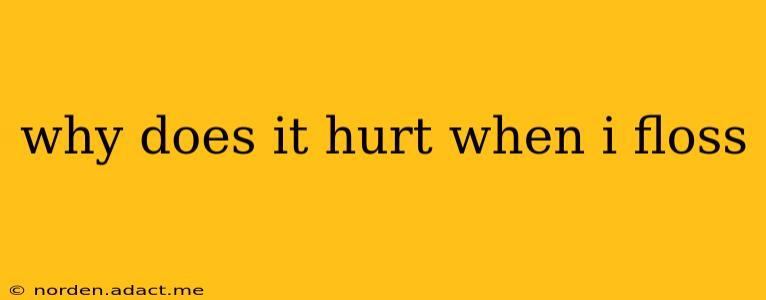Flossing is crucial for maintaining good oral hygiene, yet many people find the process painful. This discomfort can stem from several reasons, ranging from improper flossing technique to underlying dental issues. Understanding why flossing hurts can help you address the problem and make the practice more comfortable and effective.
Why Does Flossing Hurt? A Breakdown of Common Causes
The pain associated with flossing often indicates a problem that needs attention. Here are some of the most common culprits:
1. Gingivitis (Gum Inflammation):
This is perhaps the most frequent reason flossing hurts. Gingivitis is the early stage of gum disease, characterized by inflamed and bleeding gums. The inflamed gums are more sensitive, making the act of flossing uncomfortable or even painful. Bleeding during flossing is a key sign of gingivitis and should prompt you to see your dentist.
2. Improper Flossing Technique:
Snapping the floss aggressively between the teeth can damage your gums and cause pain. Gentle, careful movements are key. Using too much floss can also lead to trauma to the gum tissues. Learning the correct technique, as demonstrated by your dentist or hygienist, is paramount.
3. Gum Recession:
As gums recede, the roots of your teeth become exposed. The roots are more sensitive than the enamel-covered portion of the tooth, making flossing more painful. Gum recession is often linked to aggressive brushing, periodontal disease, and genetics.
4. Periodontal Disease (Gum Disease):
Advanced gum disease, beyond gingivitis, can cause significant gum inflammation and pain. Pockets form between the teeth and gums, harboring bacteria and causing infection. Flossing in these areas can be extremely painful and may even lead to bleeding. Professional dental treatment is essential in these cases.
5. Newly Placed Fillings or Crowns:
Immediately after receiving dental work, the gums may be sensitive and inflamed. Flossing might cause some discomfort in these areas, but this should subside within a few days. If the pain persists, contact your dentist.
6. Orthodontic Appliances (Braces):
Braces can make flossing more challenging and potentially painful. The wires and brackets can make it difficult to navigate the floss between teeth, potentially irritating the gums. Special floss threaders can help alleviate this problem.
7. Dry Mouth:
A lack of saliva can make your gums drier and more vulnerable to irritation. This can exacerbate the pain associated with flossing. Staying hydrated and using a saliva substitute (if necessary) can help mitigate dry mouth.
8. Underlying Medical Conditions:
In rare cases, pain during flossing could be linked to underlying medical conditions affecting the gums or overall health.
What to Do If Flossing Hurts
- See your dentist: If the pain is persistent or severe, schedule an appointment with your dentist. They can diagnose the underlying cause and recommend appropriate treatment.
- Use the right technique: Ask your dentist or hygienist to demonstrate the correct flossing technique. Gentle, C-shaped movements against the tooth's surface are essential.
- Try different floss types: Experiment with waxed or unwaxed floss, floss picks, or interdental brushes to find what works best for you and minimizes discomfort.
- Be patient: Gradually increase the frequency and thoroughness of your flossing, allowing your gums to adapt.
- Improve oral hygiene: Maintain consistent brushing, rinsing with mouthwash, and regular dental checkups.
Flossing, although initially uncomfortable for some, is a crucial step in maintaining healthy teeth and gums. Addressing the underlying cause of the pain will allow you to make flossing a regular and painless part of your oral hygiene routine. Don't let discomfort deter you from this essential practice; seek professional help if needed.
